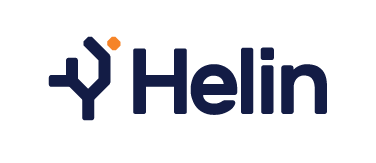Tell us a little bit about yourself and your background, for those who don’t know you?
I'm the CTO and co-founder at Helin, responsible for the technical vision, R&D and the overall software architecture. My background is in engineering, but my passion gradually shifted to computer science, especially during its transformative phase when topics like machine learning were emerging. This allowed me to integrate my engineering knowledge with self-taught computer science expertise. Our team primarily focuses on applications that function at the edge, essentially creating mini-data centers at client locations.
"Our AI work primarily revolved around vision. Combining large language models with vision."
What is your general vision on the AI and the current speed of development?
AI's trajectory over the past five to six years has been remarkable. Here's my take:
- Hardware Evolution: The advancements in hardware, particularly in GPU chips, are astounding yet often underappreciated by the end user. Nvidia, for instance, originally rooted in gaming, quickly recognized the value of their GPUs for deep learning due to their proficiency in matrix calculations. We started with their gaming cards for our early AI endeavors, like our red zone module, which required four TI 1080s in 2017. Now, edge chips offer the same computational power in a dramatically smaller and more efficient package, like the Nvidia Jetson GPU range.
- Open Source & Frameworks: With the help of companies like Huggin Face and many more, the deep learning field has immensely benefitted from the open-source movement, simplifying deployment and standardizing compute layers between hardware and deep learning outputs. However, achieving this level of standardization at the edge remains challenging.
- Large Language Models & Commercialization: The evolution of large language models, especially post the release of the BERT paper by Google Researchers, signifies a transformative phase in AI. While the current buzz around these models feels a bit hyped, their real value will emerge from their integration with private and secure user data. The challenge lies in monetizing models that have largely been built through open-source efforts.
- The Integration of Vision with AI: Our AI work primarily revolved around vision. Combining large language models with vision, especially in real-time scenarios like self-driving cars, is the next big leap. These computations, due to their need for instantaneous processing, must occur at the edge. I foresee a convergence of knowledge models and vision based models as the imminent paradigm shift in AI.
In essence, the speed of AI's progression is both exhilarating and challenging. Its real potential lies in the fusion of various domains, executed efficiently at the edge.
In your perspective, what are the advantages of implementing AI on edge devices?
Implementing AI on edge devices offers several compelling advantages:
- Low Latency: When real-time results are paramount, such as in alerting systems, processing data at the edge drastically outperforms the traditional model of sending data streams to the cloud and awaiting responses.
- Data Transmission Reliability: Even in regions with prevalent cellular coverage, there are inevitable zones of weak or no reception. Having AI models that can operate efficiently on the edge, regardless of connectivity interruptions, ensures a consistent and reliable operation.
- Efficient Bandwidth Use: By processing data at the edge, we can distill vast amounts of information into critical output, like event timestamps. This not only streamlines data communication but also saves on bandwidth, as it's much more efficient than continuously streaming raw data.
These three aspects underscore the increasing importance and viability of edge-based AI applications in our modern digital landscape.
"In essence, AI promises a future where industrial assets are not just more efficient, but also safer and more adaptable to changing demands."
The industrial sector has always been at the forefront of adopting innovations. How can AI make industrial assets more secure, safe, and efficient?
AI's potential to revolutionize the industrial sector is vast. Here are four example areas it can make a significant impact:
- Safety Protocols: AI can power advanced alerting systems to detect and protect individuals in potentially hazardous environments. Such systems can identify human presence and take proactive measures to ensure their safety, mitigating risks in areas where humans and machines co-exist.
- Operational Efficiency: AI can identify inefficiencies in routine tasks. For instance, by analyzing patterns, it can highlight when workers deviate from optimal pathways due to obstructions or habit, and suggest more efficient alternatives. Such insights can lead to time savings and increased productivity.
- Cognitive Assistance: Many jobs demand high levels of cognitive attention. AI can act as an assistant, enhancing situational awareness. This is evident in flight simulators where repetitive tasks are automated, allowing pilots to focus on more critical decision-making aspects.
- Energy and Resource Optimization: Practical applications of AI include optimizing energy consumption in solar parks. By accurately forecasting electricity prices and demand patterns, AI can instruct energy parks when to activate or deactivate, ensuring optimal energy utilization and cost-efficiency.
In essence, AI promises a future where industrial assets are not just more efficient, but also safer and more adaptable to changing demands. Its ability to process vast amounts of data and derive actionable insights positions it as a critical tool in modern industrial operations.

With every innovation, there comes a set of challenges and risks. What dangers do you associate with AI, and how doesnbsp;Helinnbsp;cope with these?
Absolutely, while AI brings unprecedented advantages, it's crucial to address the inherent risks.
- Model Integrity: One of the concerns with our vision-based AI models is the possibility of their compromise. If someone infiltrates our system, they could manipulate our algorithm, making it function differently than intended. This underscores the necessity of robust cybersecurity.
- Industry-specific Risks: In the context of industrial applications, an infected model could, for example, falsely indicate that a plant is operating normally when, in reality, it's approaching an overload situation, posing significant safety risks. Addressing such vulnerabilities is paramount for us.
- Security by Design: At Helin, we emphasize "security by design." It may seem resource-intensive upfront, but it ensures long-term safety and efficiency. Roughly 40-50% of our development time is dedicated to ensuring system security before deployment. This includes active system monitoring, rigorous code review, network separations, and other security measures, both at the host level and in the edge-to-cloud infrastructure.
- Public Perception: While the broader public debate on the implications of generalized AI is separate from our current focus, we remain aware of and engaged in these discussions. Understanding the larger landscape ensures we stay ahead in addressing potential concerns.
In essence, while AI has transformative potential, its secure implementation is vital. At Helin, we're dedicated to harnessing its power responsibly, prioritizing safety, and transparency at every turn.
"The future of Helin Platform AI lies in merging knowledge-based models with visual data. This integration would enable AI to interpret and make sense of the data it's analyzing."
Your product, the Helin Platform, plays a significant role in managing data, applications, and security on edge devices for industrial assets. What role do you envision AI playing in enhancing the platform?
Great question. AI integration into the Helin Platform has always been about optimizing edge AI software deployment in a production system. This is a highly underestimated task as it involves many microservices running on remote hardware.
- Seamless Integration: Our focus has primarily been on standardizing the hardware we utilize and refining the methodology for maintaining, training, and updating AI models on-the-fly at the edge. This foundational work has allowed us to develop a virtually plug-and-play setup based on software that's compatible with specific GPUs. This adaptability not only streamlines model updates and migrations but also facilitates a smoother transition from a few projects with limited impact to extensive rollouts across hundreds or even thousands of sites multiplying the value.
- Speed and Scalability: Our drive is to make this integration even quicker, bordering on instantaneous. We're working towards a low-code setup where users can effortlessly integrate edge AI into their operations using the Helin Platform.
- Enhanced Situational Awareness: The future of Helin Platform AI lies in merging knowledge-based models with visual data. This integration would enable AI to interpret and make sense of the data it's analyzing. While the specifics are still being refined, the objective is clear: to evolve from merely issuing basic alerts to providing actionable advice. Imagine a system that doesn't just notify you of an anomaly but also offers insights based on prior similar occurrences. This enriched context not only elevates the alert's relevance but also facilitates an analysis that could forecast future events or suggest preventive actions.
In essence, the Helin Platform is integrating AI to offer a more intuitive, insightful, and predictive tool for industries. We're transforming alerts into meaningful, actionable insights, drawing from a blend of rich historical data and cutting-edge AI algorithms.
For the benefit of our readers, do you have examples of the Helin Platform clients who have successfully harnessed the power of AI on their industrial assets?
Absolutely. Let me highlight two distinct cases from our client portfolio that demonstrate the transformative power of AI in the industrial sector:
- Remote Platform Safety System: Multiple clients operate in challenging environments with remote platforms where heavy machinery is in constant motion. Safety is paramount. Leveraging the Helin Platform, they've implemented a virtual perimeter system around specific high-risk areas on the drill floor. When certain operations are underway, and individuals inadvertently enter these zones, alarms are triggered. But the platform goes beyond just monitoring boundary breaches. It also tracks overall operations, ensuring that the right number of personnel are present and engaged. By gathering KPI statistics in the background, we enable our clients to not only enhance safety but also streamline operations. The data provides insights into personnel movements, which in turn can be used to refine processes, increasing operational speed, thereby indirectly boosting safety and efficiency.
- Crane Cable Monitoring System: Another client of ours operates cranes that are aged up to thirty years. These cranes aren't equipped with the latest sensors, leaving them vulnerable to maintenance issues like cable misalignments. A misaligned cable can (and does) lead to catastrophic events, including a complete crane collapse. Understanding this, we've equipped these cranes with off-the-shelf camera system that continuously monitors the positioning of these cables. Backed by our vision AI model, the system can detect early warning signs if a cable isn't correctly aligned. This is a prime example of condition-based maintenance powered by vision AI. By identifying potential issues early on, we empower our client to proactively address problems, ensuring both safety and continuity in their operations.
Both of these examples underscore the adaptability of our platform, showcasing how AI can drive safety, efficiency, and predictive maintenance in the industrial landscape.
"Businesses, irrespective of their technical proficiency, can deploy AI and vision models at the edge using the Helin Platform"
Given the dynamic nature of technology, where do you see the future developments for the Helin Platform heading?
The evolution of technology, especially in the realm of AI, is indeed accelerating at an unprecedented pace. For the Helin Platform, I envision several transformative directions:
- Low-Code Implementation: Businesses, irrespective of their technical proficiency, can deploy AI and vision models at the edge using our platform. The platform's inherent flexibility will eliminate the need for specialized developers, democratizing AI deployments across industries.
- Integration of Vision and Knowledge AI: One of our key strategies involves seamlessly integrating vision-based AI with knowledge-based algorithms, like large language models. The aim is to ensure that conclusions derived from visual outputs can be enriched with contextual knowledge. While vision functions would predominantly run at the edge, the fusion of visual data with knowledge models might transpire in the cloud or even locally, depending on the use case. This multi-tiered approach will enhance situational awareness, driving actionable insights.
- Adaptive Response to Energy Grid Challenges: With the increasing adoption of renewable energy, many regions, including the Netherlands, face grid capacity challenges. One interesting application of the Helin Platform involves aiding solar park operators. Given the grid's capacity challenges, electricity prices can occasionally turn negative due to an overload. To mitigate losses during such events, some of our clients have harnessed the Helin Platform. They use machine learning algorithms to monitor electricity prices in real-time. If prices dip into the negative, the system sends instructions to momentarily halt solar park operations. This not only helps in efficient energy management but also in optimal financial operations. Considering the frequency and precision required, this mirrors high-frequency trading, albeit on a slightly elongated timescale. Crucially, our platform ensures that these interactions remain secure, safeguarding solar parks from potential cyber threats.
In essence, the future for the Helin Platform is centered around adaptive AI solutions tailored for real-world challenges. By leveraging the strength of edge computing and knowledge-rich algorithms, we aim to redefine how businesses harness the power of AI.
Martijn, its been an insightful conversation. Your vision for the Helin Platform, especially in adapting AI to address real-world challenges, is truly commendable. The blend of edge computing with AI is clearly set to revolutionize multiple sectors. Any final thoughts you'd like to leave our readers with?
Thank you for the kind words. I'd just like to say that as technology advances, our primary focus remains on creating impactful, user-friendly solutions that empower businesses and improve overall safety and efficiency. We're standing on the precipice of a transformative era for AI and edge computing, and I encourage everyone to embrace it with an open mind. Remember, the true potential of technology is realized when it's wielded to make a positive difference.







